11+ Sample Used Car Purchase Agreements
-
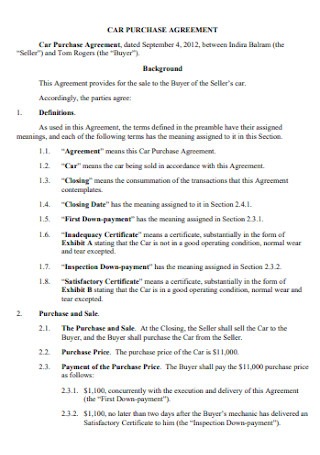
Sample Car Purchase Agreement
download now -
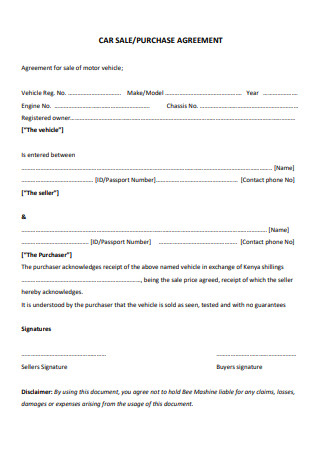
Car Sale Purchase Agreement
download now -

Agreement for Hire Purchase Car
download now -
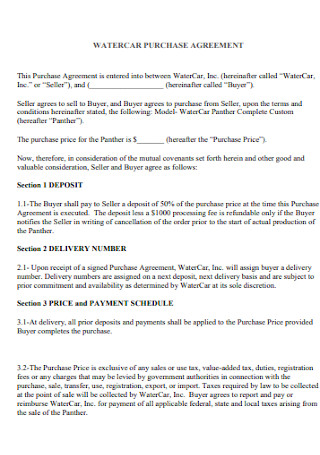
Water Car Purchase Agreement
download now -
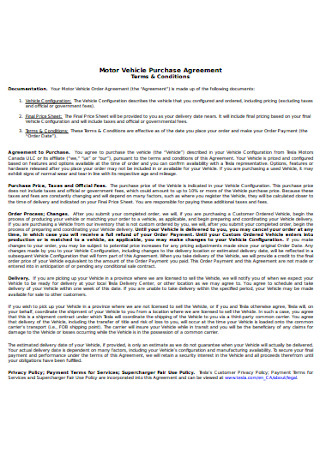
Motor Vehicle Purchase Agreement
download now -
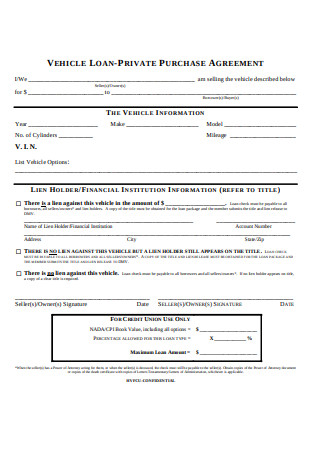
Vehicle Loan Private Purchase Agreement
download now -
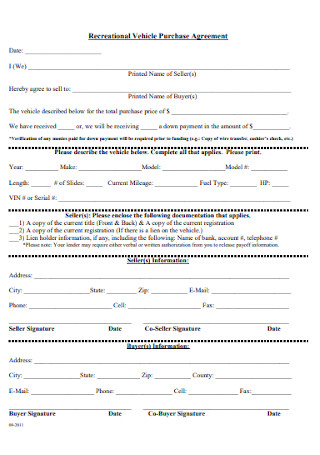
Recreational Vehicle Purchase Agreement
download now -
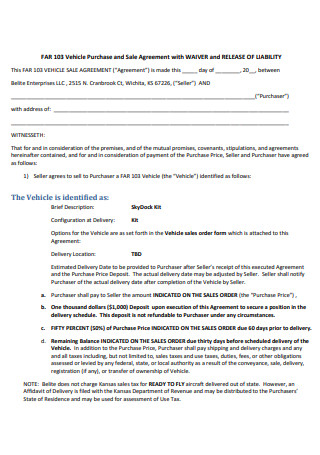
Vehicle Purchase and Sale Agreement
download now -

Private Vehicle Purchase Agreement
download now -
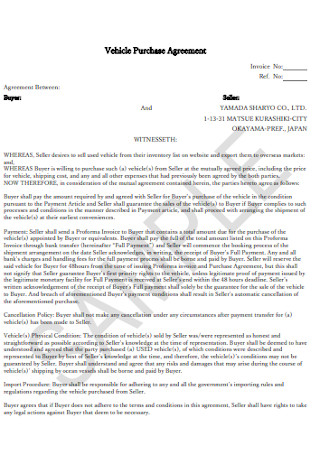
Standard Vehicle Purchase Agreement
download now -
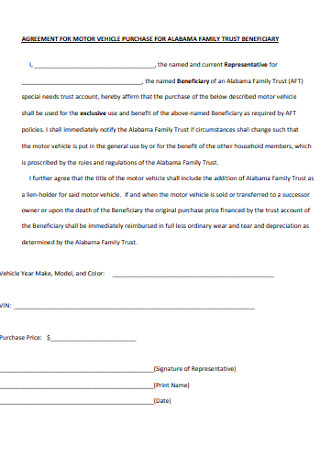
Family Vehicle Purchase Agreement
download now -

Vehicle Purchase Agreement Format
download now
FREE Used Car Purchase Agreement s to Download
11+ Sample Used Car Purchase Agreements
What is a Used Car Purchase Agreement?
What are the Contents of a Used Car Purchase Agreement?
How to Make a Used Car Purchase Agreement
Things You Should Pay Special Attention in a Used Car Purchase Agreement
FAQs
Is a Used Car Purchase Agreement a legally binding document?
Can someone back out of the Used Car Purchase Agreement?
I feel like I’m getting ripped off by the dealerships selling the used car. What should I do?
What is the difference between a bill of sale and a car purchase agreement?
What is a Used Car Purchase Agreement?
By definition, a used car purchase agreement is a legal document between the seller and the buyer that outlines the details of the terms of purchase of the used vehicle. This also serves as a sales agreement between the two parties. This document can be written as a simple, short agreement, or it can also be written as a detailed, legally binding contract, especially if you purchase a used vehicle from the dealerships and financing the deal instead of purchasing it outright. As you purchase the used vehicle, the private seller will usually ask you to sign a deed of sale (the simplest form of a used car purchase agreement). It serves as proof that the original owner that the car is no longer in their possession should it get involved in an unfortunate mishap, such as a crash or much worse, the car being abandoned.
What are the Contents of a Used Car Purchase Agreement?
A Used Car Purchase Agreement will usually share the same contents with a new one. Here are the most common terms and contents that you can find in a Used Car Purchase Agreement:
How to Make a Used Car Purchase Agreement
Should you decide to write your own used car purchase agreement, here are the necessary steps that you should take or that you can use as a guide.
1. Identify the identities of the seller and the buyer.
This is usually written in the first part of the agreement and serves as the information sheet of the parties involved. The details of the buyer and the seller, such as their legal names, contact numbers, addresses, and ID numbers are among the things to be included in this part. This part of the agreement can also include the reason or reasons why the used vehicle is being sold.
2. Write the definition of terms.
The next step would be to write the definition of the complex terms that are going to be used in the main body of the agreement. It would be ideal to make them as clear and concise as possible to avoid confusion in the future, and it would also help if you can define as many terms as possible. You can also decide to skip this step entirely if you are totally confident that the deal would go on smoothly without future repercussions.
3. Write the details of the used car to be sold.
It pays to be specific when writing this section of the agreement. In this section, the main details of the vehicle are to be identified, such as its manufacturing year, the make and model, its color, its license plate, and its engine and chassis numbers. You should also include the vehicle trim, if applicable. The overall description of the vehicle’s condition at the time of sale can be also written here. The seller can usually indicate here that they are selling the used car in an “as-is” condition, meaning that no further repairs are to be made prior to finalizing the deal. Since this is a used vehicle, it is also important that the odometer reading at the time of sale is written here, and that it should completely match the reading on the odometer instrument.
4. Write the main terms of the agreement.
In this part of the agreement, the main terms and conditions of the used car sale should be stated. Afterwards, the paragraph stating that both parties are satisfied and agree to the terms written usually follows. If the agreement immediately starts in this part, it contains blanks or spaces to be filled with personal information by the buyer and the seller. This can also contain the date and time that the agreement is made.
5. Write the loan terms and conditions.
If the seller decides to finance the used car, the terms and conditions regarding the said loan should also be written, such as the total cost of the used car after financing, the amount of money paid as a down payment, the value of the vehicle traded-in (if this option is used), the interest rate, the term of the payment period, and the amount of money to be paid in the term’s duration.
6. Leave spaces for the signatures and verify the entire document.
As you near the completion of writing the used car purchase agreement, it is important that you should leave ample space for both the seller and the buyer’s signatures, and also some space for the stamps and dry seal if you decide to get the document notarized.
Things You Should Pay Special Attention in a Used Car Purchase Agreement
If you buy a used car from a dealership, you should take extra care when going through the terms written in the purchase agreement, as dealerships can be a bit sneaky sometimes. Here are a few things in particular that you should be aware of:
FAQs
Is a Used Car Purchase Agreement a legally binding document?
Yes, that document now becomes legally binding as soon as both parties affix their signatures on it. So it is important that both parties go through the agreement and verify it multiple times before putting their respective signatures on it.
Can someone back out of the Used Car Purchase Agreement?
Unfortunately, dealerships cannot let you do this after the purchase agreement is signed. The surest way that you can attempt to back out of this is to take it into court. But usually, the court only considers it if there is a serious case of something fraudulent in the terms of the agreement.
I feel like I’m getting ripped off by the dealerships selling the used car. What should I do?
This is where you should pay extra care to the terms that you are reading. If you feel like there’s something that can be negotiated or totally removed when buying a used car, it is a wise option to bring it up to the dealer for it to get taken care of, and eventually get the contract amended. It is also wise to do your research on the dealership that you’re planning to visit in order to know how they do their respective business.
What is the difference between a bill of sale and a car purchase agreement?
A bill of sale is just basically a sales receipt, usually given when a private transaction is completed. A bill of sale is what’s used when you take the used car for re-registration and to have the original title transferred to your name. A purchase agreement is a more complex and detailed contract and it usually lists the terms and warranties of the used car being sold.
A Used Car Purchase Agreement is an important document since it provides proof of transaction of the sale and it also makes sure that it legally binds the buyer and the seller should any unforeseen issues surface later. Also completely understanding the terms and conditions written inside it is essential since you’ll be in a much better position to get the most out of your deal and also helps you avoid getting ripped off. If you’re having any trouble writing your own agreement, this article provides many examples above that you can choose from and use, or you can let it serve as your guide.
